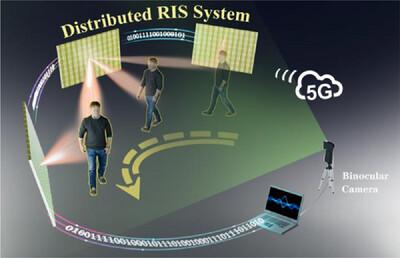一种用于动态信号增强的可重构智能表面低功耗分布式系统
IF 10
1区 物理与天体物理
Q1 OPTICS
引用次数: 0
摘要
分布式架构增强了无线通信、雷达和物联网系统的鲁棒性和适应性,但也面临节点同步、协作机制复杂、通信开销增加等挑战。特别是在构建大型系统时,功耗和通道资源管理成为瓶颈。一些研究表明,可重构智能表面(RIS)辅助系统具有结构简单、易于集成和高灵活性等显著优势。然而,目前对分布式RIS (DRIS)的研究大多局限于理想条件下的理论分析,而忽略了其功耗和计算复杂度的增加。本文提出了一种低功耗DRIS系统,该系统专为无线通信场景而设计,可动态增强各个区域的信号质量,同时保持每个RIS平均小于5.67 mW的超低功率。DRIS系统集成了预训练盲波束形成优化算法和视觉跟踪平台,即使在复杂的非视距(NLoS)场景下也能始终保持优越的性能。通过无线数据传输平台实验验证了DRIS的可靠性和有效性,表明所提出的DRIS系统是未来无线通信、雷达和物联网应用的一个有前途和有效的解决方案。本文章由计算机程序翻译,如有差异,请以英文原文为准。

A Low-Power Distributed System of Reconfigurable Intelligent Surfaces for Dynamic Signal Enhancements
Distributed architecture enhances the robustness and adaptability in wireless communication, radar, and Internet of Things (IoT) systems, but faces the challenges of nodes synchronization, complex collaboration mechanism, and increased communication overhead. Especially when building large-scale systems, power consumption and channel resource management become the bottlenecks. Several researches have shown that the systems assisted by reconfigurable intelligent surface (RIS) offer distinct advantages such as simple structure, ease of integration, and high flexibility. However, the current researches on distributed RIS (DRIS) are largely limited to theoretical analyses under ideal conditions, and neglect the increases in power consumption and computational complexity. Here, a low-power DRIS system is proposed, which is specifically designed for wireless communication scenarios to dynamically enhance the signal quality in various areas while maintaining an ultra-low power of less than 5.67 mW per RIS on average. A pre-trained blind beamforming optimization algorithm and a visual tracking platform are integrated to the DRIS system to consistently realize superior performance even in complicated non-line-of-sight (NLoS) scenarios. The reliability and effectiveness of DRIS are experimentally demonstrated via a wireless data transmission platform, indicating that the proposed DRIS system is a promising and effective solution for future wireless communication, radar, and IoT applications.
求助全文
通过发布文献求助,成功后即可免费获取论文全文。
去求助
来源期刊
CiteScore
14.20
自引率
5.50%
发文量
314
审稿时长
2 months
期刊介绍:
Laser & Photonics Reviews is a reputable journal that publishes high-quality Reviews, original Research Articles, and Perspectives in the field of photonics and optics. It covers both theoretical and experimental aspects, including recent groundbreaking research, specific advancements, and innovative applications.
As evidence of its impact and recognition, Laser & Photonics Reviews boasts a remarkable 2022 Impact Factor of 11.0, according to the Journal Citation Reports from Clarivate Analytics (2023). Moreover, it holds impressive rankings in the InCites Journal Citation Reports: in 2021, it was ranked 6th out of 101 in the field of Optics, 15th out of 161 in Applied Physics, and 12th out of 69 in Condensed Matter Physics.
The journal uses the ISSN numbers 1863-8880 for print and 1863-8899 for online publications.

 求助内容:
求助内容: 应助结果提醒方式:
应助结果提醒方式:


